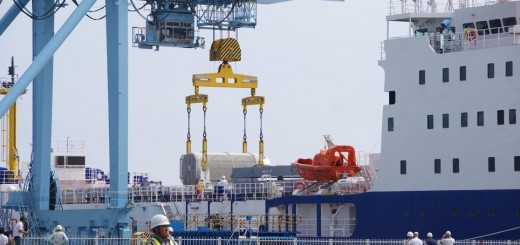News Watch 114 (September/October 2006) Nuke Info Tokyo No. 114
FBR R&D fundingOne billion yen for HLW dump candidates
Japanese industry responds to GNEP request for Expressions of Interest
Japan – Kazakhstan nuclear cooperation memorandum
FBR R&D funding
The Japan Atomic Energy Agency has published an estimate of research and development funding needs for the fast breeder reactor (FBR) cycle up to the end of the 2010 fiscal year (FY). The figure includes 37 billion yen for FY 2006 and approximately 50 billion yen per year thereafter for a total over 5 years of 248 billion yen. Operations and maintenance costs for Monju (280 MW prototype FBR, currently undergoing modifications) come to around 20 billion per year. In addition to Monju, the calculation takes into account design research for the early construction of a demonstration reactor and fuel cycle-related equipment, as well as R&D into “revolutionary technology” in preparation for commercialization.
One billion yen for HLW dump candidates
Applications for a high-level radioactive waste (HLW) dump site opened in late 2002. Since then no candidates have emerged, so the Agency for Natural Resources and Energy (ANRE) now plans to greatly increase the subsidies available to municipalities which agree to carry out a “document study”. ANRE has included this in its 2007 budget request.The document study is the first stage in the selection process. If the document study finds no evidence that a candidate municipality is unsuitable to become a HLW dump site, the selection process proceeds to a rough outline study, then to a detailed study. Just for agreeing to undertake a document study, municipalities receive 210 million yen per year. The subsidy for the rough outline study is 2 billion yen per year. (The subsidy for the detailed study has not been determined.) The maximum total payment is 7 billion yen, because upper limits are placed on the subsidies. ANRE now plans to increase the subsidy for the document study to 1 billion yen per year.
Several local governments showed some interest, but each time plans were abandoned as a result of strong local opposition. However, since plans to increase the subsidy were reported, one municipality has renewed its interest and a few others have expressed interest for the first time.
Earthquake Guidelines revised
Since July 2001 the Subcommittee on Earthquake Resisting Design (under the Special Committee on Nuclear Safety Standards and Guides at the Nuclear Safety Commission (NSC)) has been re-assessing the earthquake design safety guidelines for nuclear power plants (see NIT 112, top article and News Watch). On August 28th this Subcommittee accepted the draft revision to the guidelines with almost no changes to the version released in April and on September 19th NSC formally approved the new guidelines.Public comments were sought on the April draft, then on June 11th a previously unknown active fault was found near Chugoku Electric’s Shimane nuclear power plant. One of the Subcommittee’s members, Professor Katsuhiko Ishibashi of Kobe University, proposed that the active fault survey standards be carefully considered before approving the new guidelines. His proposal was not accepted, so he tendered his resignation from the Subcommittee at the August 28th meeting.
Second Japan-US GNEP meeting
The second round of discussions between Japan and the US about the US’s Global Nuclear Energy Partnership proposal (see NIT 113) took place in Tokyo on August 21st. Details of the discussions have not been released, but according to the August 22nd edition of the Denki Shimbun newspaper, the following issues were discussed. “The Japanese government made proposals in regard to Japan’s role under each heading, taking into account discussions which have already taken placed between Japanese and US experts. At the same time, it explained its position regarding the legal framework for progressing future cooperation between Japan and the US. For its part, the US indicated that it intended to make significant changes to the structure of the original GNEP plan. The Japanese government inquired into US intentions concerning these changes.”
Japanese industry responds to GNEP request for Expressions of Interest
On September 8th, eleven Japanese nuclear industry players submitted a joint response to the US Department of Energy’s (DOE) request for expressions of interest (EOI) in its Global Nuclear Energy Partnership (GNEP). The EOI relates to two GNEP programs, the “Consolidated Fuel Treatment Center” (CFTC) and the Advanced Burner Reactor (ABR). Joint bidders include Japan’s leading nuclear research agency, Japan Atomic Energy Agency (JAEA), uranium enrichment and spent fuel reprocessing facility owner, Japan Nuclear Fuel Ltd (JNFL), and Japanese nuclear plant makers Mitsubishi Heavy Industries, Toshiba and Hitachi. (See press release on CNIC’s web site.)
Japan – Kazakhstan nuclear cooperation memorandum
During the first visit to Central Asia by a Japanese Prime Minister, on August 28th Prime Minister Koizumi met with Kazakh President Nazabayev. They signed a bilateral memorandum on the promotion of cooperation in the field of “peaceful use” of nuclear energy. It is said that as soon as conditions have been worked out they will move toward signing a nuclear cooperation agreement.Areas of proposed cooperation include assistance for the introduction of nuclear power into Kazakhstan, development and import of Kazakhstan’s uranium (Kazakhstan boasts the second largest uranium deposits in the world), reconversion of uranium recovered from reprocessed spent fuel (enrichment would be carried out in Russia), and so on.
Plutonium data for 2005
Plutonium data for the year ending 31 December 2005 was released on September 5th. As a result of requests from CNIC, the data is more detailed than in previous years, including details about material unaccounted for (MUF). Japan’s plutonium holdings increased slightly from the previous year to 43.8 tons, 37.9 tons of which is held overseas and 5.9 tons of which is held in Japan.Detailed tables will be included in the next issue of NIT. They will be uploaded onto CNIC’s web site as soon as possible.

